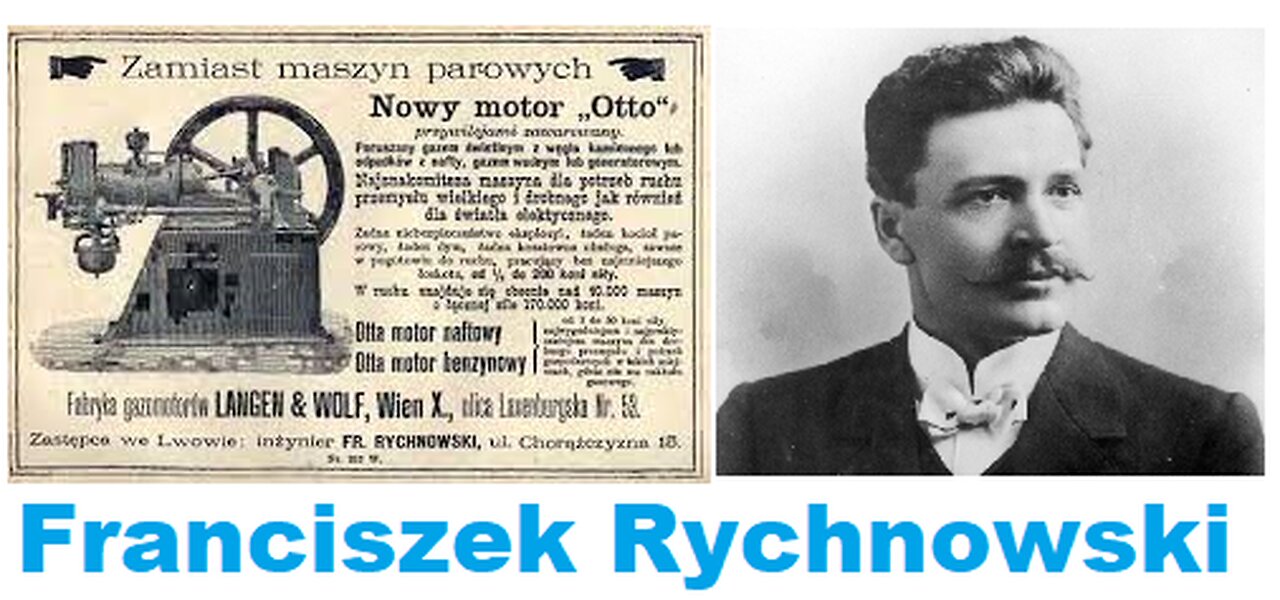Premium Only Content

Polish Genius : Franciszek Rychnowski
Aetheroid Eng. Rychnowski worth $4.5 million in 1896 / Franciszek Rychnowski, Franciszek Dionizy de Welehrad Rychnowski, using the pseudonym Iks won Chyr (surname written backwards) (born October 3, 1850 in Velehrad in Moravia[1], died July 3, 1929 in Lviv[2]) - Polish entrepreneur, engineer, physicist, photographer and inventor. He was the owner of 21 Austrian, Hungarian and German patents for fuel boilers, air conditioning and electrical devices. He postulated the existence of an electroid, considered to be a product of pseudoscience. He came from an old noble family of Polish emigrants in Moravia, of the Arma coat of arms; from the union of father Antoni Rychnowski and mother Józefa née Juepfer. He was married to teacher Maria. He studied at the OO boarding school. Piarów in Lipnik near Olomouc, and then he studied at the Faculty of Mechanical Engineering of the Vienna University of Technology. Already in his youth, he was interested in physics, mainly caloric science (the study of the properties of heat), electricity and phototechnology[1].
He patented his first invention, a caloric apparatus reducing fuel combustion, in 1878, receiving the great silver and first gold medals of the French Akademie Nationale[1][4][5] at the World Exhibition in Paris, as well as receiving a diploma of its honorary member. The technology he developed was used in heating buildings and in brewing, enabling the consumption of less than one glass of burned wood in one brew of beer, instead of the six glass used so far. Thanks to this innovation, in 1875 he received an order from Count Zamojski to modernize the brewery in Krasiczyn. In 1879, he built dynamoelectric machines intended for lighting the Sejm hall in the newly constructed building of the National Sejm in Lviv, for which he obtained an imperial-royal patent[1]. Thanks to the implementation of his projects, Rychnowski became a famous engineer, gaining a number of new orders, including: he improved the paper mill in Czerlany and the Habsburg residence in Czernowitz.In Romania, he introduced a number of innovations in the heating systems at Sinaia Castle, receiving a gold medal of merit, Serviciu Credinciosu, 1st class, from the King of Romania, Charles I[1]. He also built a fully automated kitchen in Iasi and worked on technical improvements to the Church of the Three Prelates. In 1888, Rychnowski was the first to install radiators to heat the Krakow Cloth Hall.
In the 1890s, Franciszek Rychnowski patented and described in the "Technical Journal" a furnace for central heating of apartments[7]. He was an employee of the Polytechnic School in Lviv and a member of the Polytechnic Society in Lviv[8]. In 1902, he presented his products at the exhibition of the Polytechnic Society[9]. In 1918, during the Polish-Ukrainian War, Rychnowski became the commander of the Civic Guard of the City of Lviv. In 1891, he observed electrical anomalies, and in 1896, for further research on them, he created a machine thanks to which, as he claimed, he discovered unknown matter that was a new form of energy, which he called electroid. In the same year, he informed the world Academies of Sciences in St. Petersburg, Rome, Stockholm, Philadelphia and Krakow about his discovery. The discovery gained international fame and was written about in the scientific and technical press in Europe, among others. Revue du Monde Invisible, Die ûebersinnt. Welt, La Radiographie, Psychologische Studien[4], Electrical Engineer[10] and the popular press, e.g. Le Radical[5]. A number of Polish titles also wrote about engineer Rychnowski and the electroid. The event was first described by "Kurjer Warszawski"[11], and later also by "Tygodnik Ilustrowany"[1], "Czas", "Kosmos", "Krytyka" and many others. In his weekly chronicles of July 2, 16 and 30, 1899, Bolesław Prus also mentioned the discovery[12]. This is how Tygodnik Ilustrowany described obtaining an electroid: From the machine, the electrodes flow rustlingly through a tube; you feel a refreshing scent and a cool breeze. Objects inserted into the tube are thrown out with such force that they punch a hole in the paper membrane. In the darkroom, the electroid flows out in the form of a ball of light. The nearby empty round vessels then shine with moonlight, show an increase in weight, attract other vessels and objects, and finally show a double movement: rotation around its own axis and around the beam of light. Electroid is a very subtle matter, but it seems to be weighty; it exerts pressure on the walls of the vessel, it can also be collected and stored in the vessel for several days. Falling on the plate at an angle, the electrode is reflected at the same angle in the form of a visible beam of light, and at the same time it produces a radiant star on the plate, the edges of which are revealed and turn into glowing balls. The electoid acts on the photographic plate even through bodies that are impenetrable to ordinary light
-
 1:30:30
1:30:30
Game On!
17 hours ago $7.31 earnedTop 5 things you need to know for Sports Christmas!
54.6K4 -
 1:58:10
1:58:10
Robert Gouveia
1 day agoMatt Gaetz REJECTS Report, Sues Committee; Luigi Fan Club Arrives; Biden Commutes; Festivus Waste
280K224 -
 1:31:40
1:31:40
Adam Does Movies
1 day ago $15.47 earnedThe Best & Worst Christmas Movies! - LIVE!
106K8 -
 58:10
58:10
Kimberly Guilfoyle
1 day agoAmerica is Back & The Future is Bright: A Year in Review | Ep. 183
195K71 -
 3:03:27
3:03:27
vivafrei
1 day agoEp. 242: Barnes is BACK AGAIN! Trump, Fani, J6, RFK, Chip Roy, USS Liberty AND MORE! Viva & Barnes
268K256 -
 2:05:48
2:05:48
2 MIKES LIVE
10 hours agoTHE MIKE SCHWARTZ SHOW with DR. MICHAEL J SCHWARTZ 12-24-2024
39.7K5 -
 1:14:17
1:14:17
MTNTOUGH Fitness Lab
1 day agoNavy SEAL Dom Raso: The Cold, Hard Truth About Modern Brotherhood | MTNPOD #96
30.7K4 -
 43:42
43:42
Dad Dojo Podcast
1 day ago $0.88 earnedEP14: Every Girl Dad's Biggest Fear and How To Prevent It
21.3K -
 55:06
55:06
Bek Lover Podcast
19 hours agoWill Trump Pull Off A Miracle? Other Strange News Podcast...
18.4K23 -
 55:53
55:53
PMG
1 day ago $0.60 earned"Hannah Faulkner and Courtney Reed | BEHIND THE LENS OF A TRUMP PHOTOGRAPHER"
14.4K